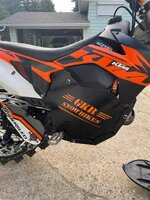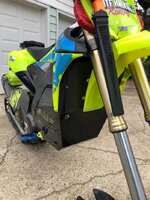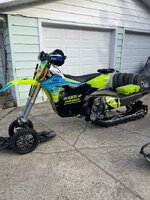Hey Ramond, where is your temp sensor located? Some will use the rad fin style sensor which, while accurate for rad temp, is not accurate for engine temp. The reason is that if the thermostat is closed which it will be often in the powder, the coolant flow is shut off to the rads. When this occurs the rads cool right off and your temp sensor would indicate a very cold condition. Once the tstat opens the rad temp will start to rise but as the cold coolant goes back into the motor the tstat will close and the cycle continues. A much better option is to use the probe style temp sensor that goes into the tstat body on the engine side of the tstat. It will be accurate to the actual engine temp. Same flaw in the rad cap style temp gauges. When there was no tstat in the bike this was not an issue (summer use) but now that we have added tstat's this is a different situation.
Getting consistent temps is a challenge as stated above. Over the last few years of snowbiking this is where I have focused my time and have evolved my engine cover and rad blocking solutions to the point that I finally have good consistent temps in most all conditions. It does require monitoring temps and cycling rad blockers as needed but that is it. I now run all day in the 180-200F range and the bike performs best in this range. Most power, no overfueling, no moisture in the oil.
I started with home made engine blankets, hand made hard snow shields, common industry available engine blankets, pretty much tried them all. As things progressed I realized that complete closure was where I started to have great results. The cooling system on the bikes using the just the radiators is more than sufficient to keep the engine cool as long as they can flow air when they need to. I have seen many riders who ride in the powder, bike runs cold, then they get to the trail and the bike overheats. This is because the rads are iced over and air cannot flow through them. I see guys peeling off engine blankets, etc. thinking they are the cause of the overheat. Keeping the rads blocked and clear in the powder and then removing one or both blockers on the trail or in low snow conditions is the answer.
I have developed an engine cover that has been working fantastic and provides complete engine coverage, full frontal closure when needed, and gives tremendous access for service and repairs. I have been building them steady and refining the design over the last couple seasons to the point I am ready to hit the market. (soon) So far I haven't needed to, I can barely keep up as it is. You can see them in much more detail on my FB page, link in sig below. Here is a couple pics of the latest evolution.








